Skeletons Underground
(WaterEfficiency.net) – Meeting the challenge of pipe rehab solutions with new materials and advanced technologies
By Ed Ritchie
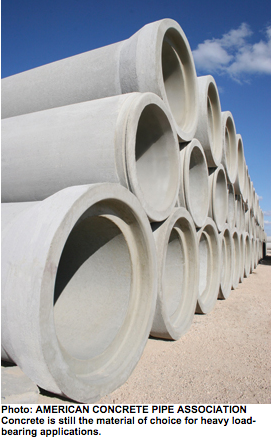
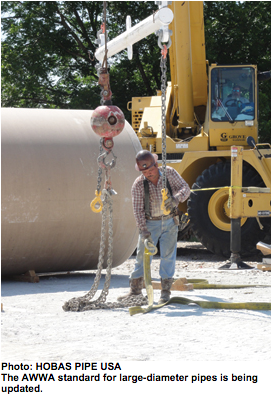
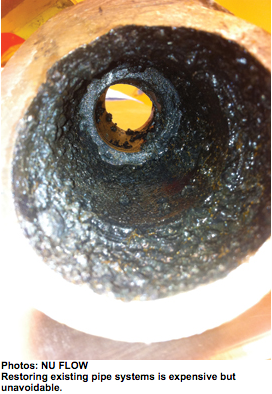
The challenge of repairing and replacing the pipes that support our nation’s water infrastructure is growing in urgency, but are we responding? Not fast enough, according to the latest study from the American Water Works Association, “Buried No Longer. Confronting America’s Water Infrastructure Challenge.”
Of course, when the majority of the pipes were installed over 50 years ago, and a good percentage are actually closer to 100 years of age, it’s no surprise. Nonetheless, there’s a great contrast between what we put in the ground 50 years ago and what we have today. And on the positive side of the ledger, there are a number of ways to salvage the neglected pipe, and replacement materials have benefitted from the data gained over the years.
In fact, today’s utility and commercial water engineers sometimes find that it’s hard to keep up with all the technology breakthroughs occurring in pipe materials and maintenance. To start, look at trenchless technology as one of the most beneficial trends, advises Fadi Alabbas, CPM manager for the western region at Veolia Water, Chicago, IL.
“This technology has evolved over the years and made it possible to do projects that we couldn’t do earlier,” says Alabbas. “For example, for a cure-in-place liner, in the old days you would have to get a liner that behaves structurally like a pipe. But let’s say it’s an old clay pipe and deteriorating. You had to excavate and replace it with something that’s structurally capable of withholding the soil and behaves like a new pipe.
“So we needed a fairly thick liner that reduced the capacity, and that was an issue especially if we had six-inch pipe and it reduced the capacity to five-and-a-half inches,” he continues. “We had less flow and more problems with inspection cameras and cleaning equipment. Now we’re using a fiberglass liner that can maintain structural integrity with just an eighth of an inch in reduction, so it’s a much thinner liner and you can still do the maintenance.”
As for materials, Alabbas notes that Polyethylene is popular, but recent advances in joining sections for PVC are boosting the use of this familiar material.
“In the past, PVC couldn’t be fused together, but now it can, and it’s gaining use in the market over the past two to three years,” he says. “That’s good, because you want material that’s approved for carrying potable water and PVC is very economical.”
Deeper and longer segments of pipeline also provide benefits.
“We’re seeing microtunneling that utilizes the same method as doing large tunnels through mountains, but on a smaller scale,” says Alabbas. “You start with a launching pit and receiving pit, then let’s say you have an 18-inch pipeline and a 600-foot dredge, you can hit your target within a quarter of an inch. It’s very precise, and with sewers this means gravity flow, so point-to-point has to be precise, or you compromise your hydraulics. Maintaining accuracy to a quarter of an inch is very exciting.”
Improvements to trenchless technology allow drillers and bursters to push both vertical and horizontal limits, according to Bill Haines, president of the Northeast Trenchless Association, Topsfield, MA.
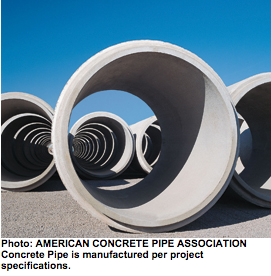
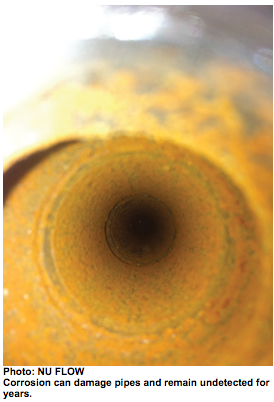
“Pipe bursting from 12 to 18 inches used to be thought of as very difficult, even in the right conditions,” says Haines, “but it’s become relatively commonplace now. The drilling rigs and tracking equipment are sophisticated to the point where the products are going longer and deeper and farther with improved accuracy. So while the industry is relatively new, we’re pushing the limits of the technology.”
“In some cases, engineers jump on the trenchless bandwagon without doing their homework, or don’t realize what’s involved, so they under-design a project or create problems down the road,” observes Haines. “With that said, there’s a lot of excellent consultants out there with a lot of trenchless experience, and they have the right information, and their projects go off without a hitch.”Typical examples of trenchless technology include bursting, directional drilling, microtunneling, and pipe ramming. Haines notes that as contractors push deeper, they gain more soil data to further advance the industry’s hardware. Even though trenchless offers less disruption at construction sites, and its reach is expanding, Haines stills sees a challenge in educating utilities, and the pipe community in general, to the proper applications for the technology.
As an example of ongoing success for the trenchless industry, Haines cites the City of Houston’s record of bursting more than 1,000,000 feet of pipe per year.
“They are typical of the Sun Belt states with sewers that have suffered the effects of hydrogen sulfide for years and years,” says Haines. “So this is a means of upgrading the infrastructure while minimizing disruption. The dominant material for rehabbing is Polyethylene. The joints don’t leak, and it handles the forces of the environment as well as a hydraulic, although we are seeing some other materials such as PVC and ductile iron. Under really high-pressure steel pipe is still the product of choice, especially when you get into some of those really long high-pressure gas mains and things like that.”
Steel pipe also excels in water transmission applications, notes Rich Mielke, director of engineering, Northwest Pipe Company, Raleigh, NC.
“We see pipes of 24 inches and larger as water transmission, and 85% of the footage for most owners is in the distribution area. When you start talking about water transmission pipelines, it’s three basic materials, and they’re all steel-based or iron-based. We design our pipe systems for the needs of the owner, and typically they need to resist pressure or surge pressure, which is unexpected events in a pipeline that happen when you start a big pump or close a big valve in a system.”
Mielke adds that steel pipe is engineered for a product that can last in excess of 100 years, and that’s accomplished by modern quality bonded coatings.
“There is a three-layer tape system which is still used today, and as far as most modern coatings, they are Polyurethanes that have become very popular in the last 10 years. They perform well as a corrosion barrier with, or in conjunction with, cathodic protection, which is often used on water transmission pipelines to extend the service life in excess of 100 years. There’s another option: it’s a cement mortar coating, and it’s used also in concrete pressure pipe. And you can also use cathodic protection on concrete pressure pipe.
“Basically, all the major owners in the United States and Canada use steel pipe in one shape or the other,” adds Mielke. “Its use in water transmission can be traced back to the 1850s, and the roots of our company can be traced back to 1878. So steel pipe has as long a performance history of any transmission pipe material in North America.”
“We’ve seen that a Polyethylene coating helps to prolong the service life of steel pipe for more than 100 years, but High Density Polyethylene Pipe [HDPE] stands alone as a unique material for a wide variety of pipe applications,” says Tony Radoszewski, executive director of the Plastics Pipe Institute, Irving, TX.
The process of joining HDPE sections is a key factor. The sections are joined by melting one end of each pipe and fusing them together. “The molten polymer knits together,” says Radoszewski. “When we test the pipe to ductile failure, the pipe always fails in the wall rather than the joint. This leads some people to conclude the joint is stronger than the pipe. So with a fused joint for water and sewer systems, you eliminate exfiltration and infiltration as well.”
When tested for life expectancy by Jana Laboratories, a study of the effects of disinfection on the lifetime of polyethylene (PE) pipes stated that PE can last in excess of 100 years under most water quality conditions, service environments, and disinfection techniques.
For HDPE, the predominant material formulation in the past was either PE 3408 or PE 3608. “They both are great materials, but the industry has consistently looked for ways to improve the performance of the product,” says Radoszewski. “In this case, the improvement is PE 4710, a more robust material, in terms of performance for both short-term and long-term use. It offers a higher pressure rating and demonstrates an exceptionally long service life. Because the water market mostly follows AWWA standards, municipalities can only take advantage of the higher design capabilities of PE 4710 in small-diameter water service lines. The good news is that the standard for larger-diameter distribution and main lines is currently being updated, so it won’t be long until the water industry can utilize this high-performance material in the entire system.”
Repairing HDPE isn’t complicated, but Radoszewski believes that there’s a lack of awareness in the utility industry regarding the technology, whereas repair procedures for ductile iron and PVC are common knowledge. “Let’s say you have a backhoe that damages some pipe,” he explains. “By using electrofusion couplers, you eliminate the need to excavate the pipe and refuse the ends. It’s very simple and available, but it’s not what most contractors are used to.”
First timers might also lack an appreciation for the size and sophistication of fusing equipment, such as the MegaMc 1600 four-jaw fusion machine, manufactured by McElroy, Tulsa, OK. With jaws that can hold and butt fuse HDPE as small as 20 inches to as large as 65 inches in diameter, there’s no mistaking its purpose when it clamps down with 30,000 pounds of power in each of the four jaws. The force is needed in clamping and re-rounding pipe for a high-quality fusion process.
Contractors kept a MegaMc 1600 busy in a recent project for the St. George and Washington Canal, in St. George, UT. Pipe manufacturer JM Eagle, Los Angeles, CA, supplied 5 miles of 63-inch HDPE DR 32.5 pipe to replace most of the Washington Canal in St. George, saving thousands of acres of water. The canal had a history of leakage and evaporation after it was concrete-lined in the 1970s, with losses estimated at 10% annually (about 4,400 acre-feet) due to seepage, according to Doug Wilson, Washington County Water Conservancy District, project coordinator.
JM Eagle manufactures HDPE water and sewer pipe in diameters of one-half inch up to 63 inches, and the company can add color striping to identify applications, such as a green stripe for sewers and blue for reclaimed water. In early 2011, the city of West Palm Beach, FL, used 5,600 feet of 24-inch blue and green stripe HDPE for a force main and water main across the inter-coastal waterway in preparation for a new bridge installation.
In the context of transportation related projects, concrete pipe continues to find use where municipalities and departments of transportation require heavy load bearing applications.
“Concrete excels when you have our flexibility to handle almost any structural load,” says Al Hogan, P.E., Eastern Region Engineer at American Concrete Pipe Association in Irving. “Whether it’s traffic, an airport, or a railway, under severe loading we have the flexibility to accommodate these conditions, and that’s our strength.”
Hogan notes that concrete pipe is manufactured to specification, so it’s ideal for situations such as deep tunnels that require thicker walls and increased strength. Such was the case with a $2.3 billion sewer improvement program for the Milwaukee Metropolitan Sewerage District. The system eliminates sewage that previously was released into Lake Michigan, by transporting wastewater to collector sewers for treatment or temporary storage in 19.4 miles of tunnels at depths of up to 325 feet. The tunneling and pipe jacking portion of the project required 13,500 feet of 84-inch diameter reinforced concrete jacking pipe.
“We are comfortable with 100-year service life,” says Hogan. “There are occasions when there may have to be some maintenance, but it’s rare and usually something that happens late in the service life. If there’s maintenance required, even in a fairly severe situation our product is still going to provide some structural support, and in most conditions we still have a structure in place that can be rehabilitated and gain some additional service life.”
One of the few weak points for concrete isn’t the concrete itself—it’s the steel wire that’s embedded into the pipe structure for additional strength, according to Mike Higgins, vice president Pure Technologies, Dallas, TX. “The wire can degrade over time and start breaking,” he says. “When you get enough water breaks, the whole concrete pipe can suddenly fail, and it’s a very bad situation.” Preventing that failure with regular condition assessments can save money and prevent public relations disasters.
“In general, we’ve seen a move in the water and wastewater industry to focus on condition assessment of pressurized pipe,” says Higgins. “Previously, there was a lot of work done on gravity pipes in the sewer industry but not much in water mains, but we’ve seen growth in that area. There are a couple of fundamental reasons there’s an increase of failures and large-diameter pipes, and you see stories on the six o’clock news displaying the utility’s worst problems. It hurts the public’s confidence, so there’s a lot of political pressure on utilities to do something about their large-diameter pipes. But capital funds are so limited, they can’t really replace them all. The alternative is to inspect and assess the condition of a pipe and repair isolated areas rather than full-blown capital replacement projects.”
Higgins notes that the demand for assessments has spurred a wide range of inspection methods, including Electromagnetic inspection to accurately establish the baseline condition of PCCP by detecting and quantifying the number of breaks in prestressing wire that reinforces concrete pipes; leak and gas pocket detection, structural monitoring; structural analysis software; and pressure transient monitoring.
“We also have a family of tools dedicated to looking at wire inside the pipes,” adds Higgins. “The Pipe Diver is a technology we introduced a couple of years ago, and it can be put into service while the pipeline is operating. As it flows through the pipeline, it’s like a long snake, and it gets a magnetic signature every 20 feet as it looks for wire damage problems. We recently introduced our Smart Ball technology. It just rolls within the pipe along with the water flow and records condition assessment data on the ball for a very high level of information, and details on leaks in pipes.”
Maintaining structural integrity will become even more critical for pipes as the trend in deeper tunneling continues to grow, according to Kimberly Paggioli, P.E. vice president, marketing and quality control, Hobas Pipe USA, Houston, TX. Hobas is a producer and supplier of corrosion resistant centrifugally cast fiberglass reinforced polymer mortar pipe systems, under license from Hobas Engineering AG of Switzerland.
“We’re seeing a trend for larger diameter and deeper sewers,” says Paggioli. “We have several projects ongoing now at depths of 200 feet. “Our project at Ladybird Lake was less than 100 feet, but anything deeper than 25 feet has to be some sort of tunneling method, and there’s a lot of microtunneling happening around the country using remotely controlled automated equipment.”
The tunnels under Ladybird Lake are part of The City of Austin’s Downtown Wastewater Tunnel Project, designed to improve the current wastewater collection system capacity with an 18,600-linear-foot tunnel to reduce current flows in the system’s primary wastewater interceptors. The project includes excavation of approximately 18,600 linear feet of tunnel, utilizing 121-inch- and 90-inch-diameter tunnel boring machines, installation of 54- to 90-inch-diameter glass-fiber-reinforced polymer mortar pipe. Four new shafts will be approximately 28 feet in diameter and 58 feet to 86 feet in depth.
“In the next few months we’re to start a project for the City of Houston, and we’ll be creating a 120-inch-diameter pipe. Previously we had manufactured up to 110 inches. We have other projects that are even larger, and I foresee in the near future that we will continue to expand our diameter range,” says Paggioli. “These projects are getting deeper because it was common to have lift stations in shallow pipes, but the trend has been to take those lift stations offline and build deeper systems that have storage capacity within them but are based on gravity systems. So you need very deep systems.”
As projects demand deeper pipe placement, Hobas has gone to great lengths to verify and ensure the performance of the pipe under external pressure. They have tested products and joints up to 100-psi external pressure and developed new equipment to manufacture and test larger pipe diameters.
“We also do work for aging infrastructure along with new construction and manufacture pipe for slip lining, which is new pipe inside an existing type,” explains Paggioli. “When you have an existing long run, that’s an asset to be able to go in and rehabilitate that and give that pipe a 100-year life with minimal construction involved; it’s a benefit to the public.”
With its many historic buildings, Washington DC—and, for that matter, federal buildings across the country—are prime candidates for pipe corrosion, notes Paul Corneil, director of research and development at Nu Flow, San Diego, CA, a manufacturer and installer of cured-in-place epoxy pipe lining solutions. The company began its services in 2000 with the rehabilitation of drain lines and has done many projects on both drains and small-diameter pipes in government buildings, and commercial and residential.
“By the time people realize there’s a problem with a drain, it’s usually in terrible shape,” says Corneil. “They’re badly corroded or starting to separate, or roots have entered. Inside older buildings, it’s typically a cast-iron vertical stack that has corroded inward, so the diameter of the pipe decreases from something like four inches to three.”
In such cases, the problem is aggravated if plumbers scrape the insides of the pipes, because the scale falls down and creates a blockage. From then on, the freshly scoured pipe corrodes much faster.
“If you stop inside corrosion, you’ll have something that will last a long time,” says Corneil. “We did drain lines in a DC building that were literally bits and pieces, and when it rained the water came into the offices because there was no pipe left. These pipes were behind layered brick one foot back, and there was brick around the drain, so the pipe chase would have been disastrous to replace.”
The Nu Flow process uses high-pressure sand blasting to clear pipes of corrosion, followed by cured-in-place epoxy, and liners for larger-diameter pipes up to 12 inches.
“We offer the structural liner and can mix and match, so for a large diameter of six to eight inches, we can do a structural liner and coating combination,” he adds. “Let’s say you have an issue where you have a section of pipe that has a set crack, and there’s a structural issue we can put a sectional liner in rather than from one end of the pipe to the other, but in the middle such as a 20-foot center section, then coat entirely over the top of it. So having that ability is very handy. Our liners test through 300 psi, so it’s above minimum strength.”
All told, the solutions for pipe rehab offer a variety of methods and materials, and the range in applications runs from one-half inch to more than 100 inches in diameter. With lifetimes for most materials hovering around 100 years, our aging water infrastructure could be renewed and maintained to a much higher standard.
But as the AWWA notes, “Restoring existing water systems as they reach the end of their useful lives and expanding them to serve a growing population will cost at least $1 trillion over the next 25 years, if we are to maintain current levels of water service.” So more than ever, it’s time to harness our resources and avoid the consequences of further neglect.
Author’s Bio: Writer Ed Ritchie specializes in energy, transportation, and communication technologies.

